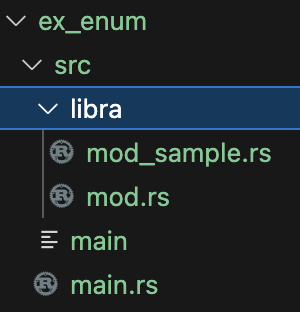https://doc.rust-jp.rs/rust-by-example-ja/custom_types/enum/testcase_linked_list.html
のコードでrefと&で何が違うのと思ったのですが、
Rust by exampleの以下のページに出てくるrefパターン
https://doc.rust-jp.rs/rust-by-example-ja/scope/borrow/ref.html
の解説は、
—————————-
// 左辺に`ref`をつけることによる借用と、右辺に`&`をつけることによる借用は等価
let ref ref_c1 = c;
let ref_c2 = &c;
ということなので、どちらも借用ですが似てるようで意味は全く異なります。
該当部分のコード全体をいかに再掲(長ったらしいので日本語は削除)しますが、タプル全体の文字列と長さの取得処理は再帰処理を使っています。
https://doc.rust-jp.rs/rust-by-example-ja/custom_types/enum/testcase_linked_list.html
use crate::List::*; // equivalent to following two lines, it's a short form of the enum List
//use crate::List::Cons;
//use crate::List::Nil;
#[derive(Debug)]
enum List {
// Cons: Tuple struct that wraps an element and a pointer to the next node
Cons(u32, Box ),
// Nil: A node that signifies the end of the linked list
Nil,
}
// Methods can be attached to an enum
impl List {
// Create an empty list
fn new() -> List {
// `Nil` has type `List`
Nil
}
// Consume a list, and return the same list with a new element at its front
fn prepend(self, elem: u32) -> List {
// `Cons` also has type List
Cons(elem, Box::new(self))
}
// Return the length of the list(using recursive call)
fn len(&self) -> u32 {
// `self` has to be matched, because the behavior of this method
// depends on the variant of `self`
// `self` has type `&List`, and `*self` has type `List`, matching on a
// concrete type `T` is preferred over a match on a reference `&T`
// after Rust 2018 you can use self here and tail (with no ref) below as well,
// rust will infer &s and ref tail.
// See https://doc.rust-lang.org/edition-guide/rust-2018/ownership-and-lifetimes/default-match-bindings.html
match *self {
// Can't take ownership of the tail, because `self` is borrowed;
// instead take a reference to the tail
Cons(_, ref tail) => 1 + tail.len(),
// Base Case: An empty list has zero length
Nil => 0
}
}
// Return representation of the list as a (heap allocated) string(using recursive call)
fn stringify(&self) -> String {
match *self {
Cons(head, ref tail) => {
// `format!` is similar to `print!`, but returns a heap
// allocated string instead of printing to the console
//println!("st: {}, {}", head, tail.stringify());
let ret: String = format!("{}, {}", head, tail.stringify());
println!("{:?}", ret);
ret
},
Nil => {
format!("Nil")
},
}
}
}
fn main() {
// Create an empty linked list
let mut list = List::new();
// Prepend some elements
list = list.prepend(1);
list = list.prepend(2);
list = list.prepend(3);
// Show the final state of the list
println!("linked list has length: {}", list.len());
println!("{}", list.stringify());
}
コメントにあるように2018年版のRustからは*selfとref tailの*とrefは不要になった(&とrefを推論する)そうで、確かにそう変えてもコンパイルは通ります。となると、fn stringify(&self)も同じように書き換え可能なので、このソースでrefを使う必要はなくなりますが。
match self {
// Can't take ownership of the tail, because `self` is borrowed;
// instead take a reference to the tail
Cons(_, tail) => 1 + tail.len(),
// Base Case: An empty list has zero length
admin

